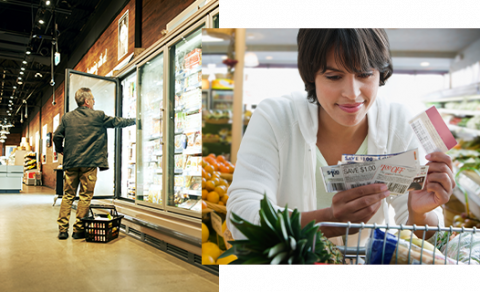
Shop Smart
To get the most for your dollar, follow the tips in this section as you shop at your favorite food store.
Back to Healthy Eating on a Budget
Tips for Every Aisle
Use the tips below to buy budget-friendly and healthy options from each food group.
Note: Click on the top row to expand the table. If you are on a mobile device, you may need to turn your phone to see the full table.
Find fruits and vegetables in the produce section, frozen foods, and in the canned and pantry food aisles. Compare prices to find the best buys.
- Buy “in season” produce which often costs less and is at peak flavor. Buy only what you can use before it spoils.
- Frozen fruits and vegetables are always "in season." They're picked at peak ripeness and frozen quickly to maintain taste, quality, and nutrients.
- Choose fruits canned in water or 100% fruit juice and vegetables with “low-sodium” or “no salt added” on the label. These products are just as nutritious as fresh, and often cost less.
- Stock up on frozen vegetables without added sauces or butter. Frozen vegetables are as good for you as fresh and may cost less.
-
Canned and frozen fruits and vegetables last much longer than fresh. They can be a quick way to add fruits and vegetables to your meal.
-
For more information, check out the MyPlate tip sheets: Focus on Whole Fruits and Vary Your Veggies.
Find grains in many areas of the store, including the bread, cereal, snack, and pasta and rice aisles.
- Make half your grains whole grains. Types of whole grains include whole wheat, brown rice, bulgur, buckwheat, oatmeal, whole-grain cornmeal, whole oats, and whole rye.
- While shopping, check ingredient lists and pick the items that have a whole grain listed first.
- Rice and pasta are budget-friendly grain options. Try freezing rice in dinner-sized portions to save time on future meals.
- Choose hot cereals like plain oatmeal or whole-grain dry cereal.
- Try new whole-grain snack ideas, like switching to whole-wheat crackers or popping your own popcorn.
- Many grains are available in the frozen aisle and can be convenient options. Try steam-in-the-bag rice or take-and-bake bread.
- For more information, check out the MyPlate tip sheet: Make Half Your Grains Whole Grains.
Find protein foods throughout the entire store. They can be found in the fresh meat section, frozen foods section, dairy section, and canned and pantry food aisles.
- Some low-cost protein foods include beans, peas, and lentils such as kidney beans, lima beans, split peas, and garbanzo beans (chickpeas).
- Beans, peas, and lentils cost less than a similar amount of other protein foods.
- To lower meat costs, buy the family-sized or value pack and freeze what you don't use.
- Choose lean meats like chicken or turkey. When choosing ground beef, make sure it's lean (at least 93% lean/fat-free) ground beef.
- Seafood doesn’t have to cost a lot. Try buying canned tuna, salmon, or sardines. These items store well and are a low-cost option.
- Don’t forget about eggs! They’re a great low-cost option that’s easy to make.
- For more information, check out the MyPlate tip sheet: Vary Your Protein Routine.
Find dairy foods in the refrigerated and pantry aisles.
- Choose low-fat or fat-free milk. These have just as much calcium, but fewer calories than whole and 2% milk.
- Buy the larger size of low-fat plain yogurt instead of single flavored yogurt. Then add your own flavors by mixing in fruits.
- Choose cheese products with "reduced fat" or "low-fat" on the label.
- Check the sell-by date to make sure you're buying the freshest products.
- For more information, check out the MyPlate tip sheet: Move to Low-Fat or Fat-Free Dairy.
- Drink water instead of sodas or other high-sugar drinks. Water is easy on your wallet and has zero calories. Take a reusable water bottle is when on the go.
- Save time, money, and calories by skipping the chip and cookie aisles.
- Choose the checkout lane without the candy shelves, especially if you have kids with you.
- For more information, check out the MyPlate tip sheets on grocery shopping, healthy food preparation, eating healthy on a budget, and more.
Understanding the Price Tag

The price tag on the shelf has a lot of information. It’s good to understand what the numbers mean. This section breaks it down for you.
- Retail Price (shown on the right side of label): This is the price you pay for one, single item.
- Unit Price (left side in the colored box): This is the cost of an item by its size (or unit). This can be by the pound, ounce, quart, or another measurement. It can be very useful when comparing two items.
This image shows two different price tags on a shelf. Based on the unit price, you can see that the larger container (32 oz. container pictured on top) is a better buy because you are getting more for your money.
How is the unit price found?
TOTAL PRICE ÷ SIZE = UNIT PRICE
Example: What is the unit price of a 6 oz. yogurt that has a retail price (the price you pay) of $0.72?
$0.72 ÷ 6 oz. = $0.12
The unit price of this yogurt is $0.12 per oz.





